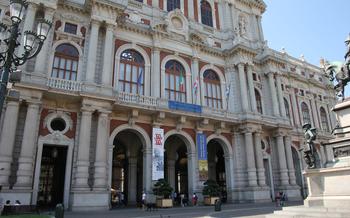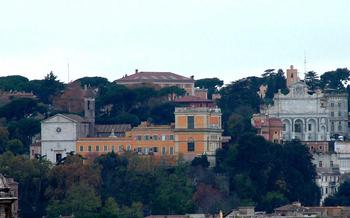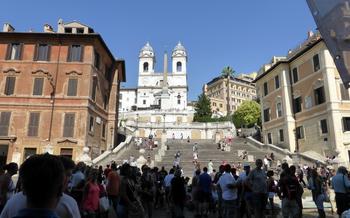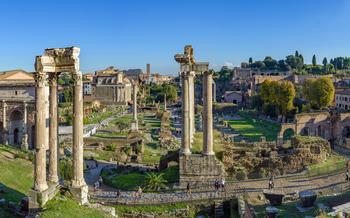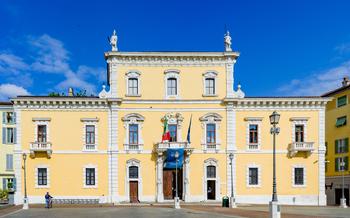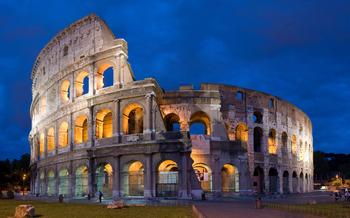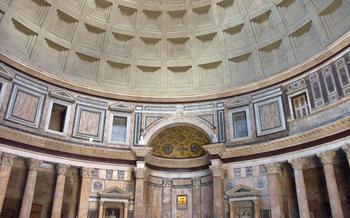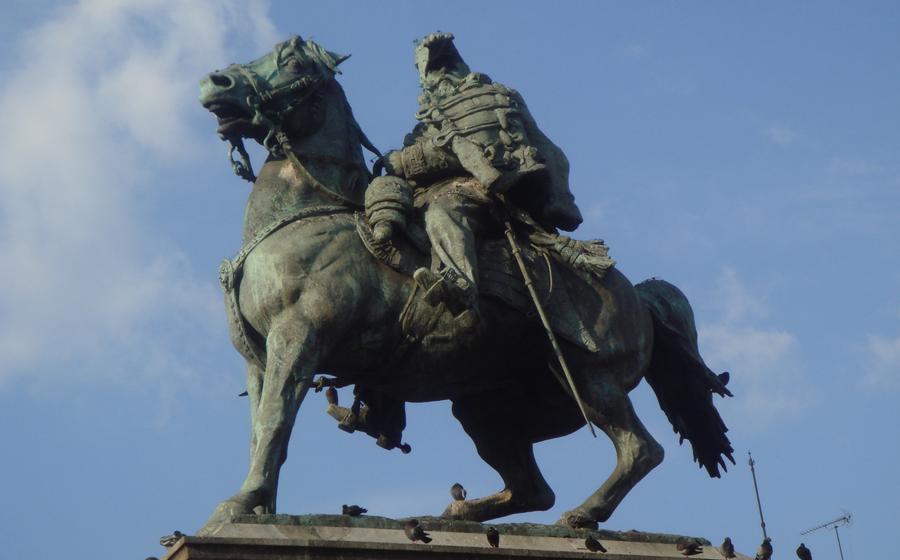
Monumento a Vittorio Emanuele II (Monument to Victor Emmanuel II)
- Introduction: A Monument to Unity and National Pride
- Historical Context
- Architectural Features
- The Quadriga
- The Altar of the Fatherland: A Sacred Space Honoring Italy's Fallen Soldiers
- The Museo del Risorgimento: A Journey Through Italian Unification
- The Tomb of the Unknown Soldier: A Poignant Tribute to Italy's Fallen Soldiers from All Wars
- Changing of the Guard Ceremony
- Piazza Venezia: The Heart of Roman Life
- Practical Tips for Visitors
- Photography Opportunities: Capturing the Grandeur and Beauty of the Monument Through Your Lens
- Nearby Attractions
- Local Customs and Etiquette
- Insider Tip: Explore the Secret Underground Passages
Introduction: A Monument to Unity and National Pride
In the heart of Rome, Italy, stands the majestic Monumento a Vittorio Emanuele II, a grand tribute to the nation's first king and a symbol of Italian unification. Soaring high above Piazza Venezia, this imposing monument embodies the spirit of the Risorgimento, the 19th-century movement that led to the unification of Italy after centuries of division.
Commissioned in 1885, the monument was designed by Giuseppe Sacconi and inaugurated in 1911, marking the 50th anniversary of Italian unification. Its colossal size, intricate details, and allegorical figures reflect the grandeur and significance of this historic event, making it a must-see destination for visitors to Rome.
The monument is easily accessible by public transportation and offers a range of practical information for visitors, including opening hours, ticket prices, and guided tour options. Whether you're a history buff, an architecture enthusiast, or simply seeking to immerse yourself in the heart of Italian culture, the Monumento a Vittorio Emanuele II stands as an enduring testament to the nation's rich heritage and unwavering spirit.
Historical Context
The Monumento a Vittorio Emanuele II stands as a testament to Italy's hard-fought unification, a pivotal period known as the Risorgimento. This movement, spanning from the early 19th century to 1871, sought to unite the Italian peninsula, which had been divided into separate states for centuries. Victor Emmanuel II, King of Sardinia, emerged as a key figure in this struggle, leading the charge towards unification and becoming the first king of a united Italy in 186
The decision to erect a monument honoring Victor Emmanuel II and commemorating the sacrifices made during the Risorgimento was a symbol of national pride and unity. The monument's grand scale and elaborate design were intended to convey the significance of this historic transformation, paying homage to the fallen heroes and celebrating the birth of a new nation.
Architectural Features
The Monumento a Vittorio Emanuele II stands as a testament to the grandeur and opulence of the late 19th-century Italian architecture. Its sheer size, towering over Piazza Venezia, commands attention and awe. The monument's exterior is clad in gleaming white marble, sourced from the renowned quarries of Botticino in Brescia. This luminous material not only adds to the monument's grandeur but also symbolizes the purity and unity of the newly unified nation.
The intricate details and allegorical sculptures adorning the monument are a testament to the skill and artistry of the Italian craftsmen. The monument's facade features a series of imposing columns and arches, creating a rhythmic and harmonious composition. These architectural elements are interspersed with intricate carvings, bas-reliefs, and statues, each with its own unique symbolism and narrative.
The allegorical figures and symbols that adorn the monument are particularly noteworthy. These figures, often representing virtues, historical events, or Italian regions, add a layer of depth and meaning to the monument's overall design. For example, the statues of Roma and Italia, prominently displayed on the monument's facade, symbolize the unity and strength of the newly formed Italian state.
The Quadriga
Crowning the Monumento a Vittorio Emanuele II, the majestic quadriga, a four-horse chariot, stands as a symbol of Italy's triumph and unity. Cast in bronze and soaring high above the city, the quadriga is a masterpiece of artistic expression and engineering prowess. The powerful steeds, harnessed together and galloping forward, embody the nation's strength and determination.
The quadriga's design is a testament to the skill and imagination of sculptor Carlo Marocchetti. The horses, with their rippling muscles and flowing manes, seem to burst forth from the monument, creating a sense of dynamism and movement. The charioteer, representing Italy itself, stands tall and proud, guiding the chariot towards a brighter future.
The quadriga not only adds to the monument's grandeur but also offers visitors a breathtaking panorama of Rome. From the viewing platform at the top of the monument, one can admire the city's iconic landmarks, including the Colosseum, the Roman Forum, and St. Peter's Basilica. The panoramic views from this vantage point are simply unforgettable, making the ascent to the quadriga a must-do experience for any visitor to the Monumento a Vittorio Emanuele II.
The Altar of the Fatherland: A Sacred Space Honoring Italy's Fallen Soldiers
Within the grandiose structure of the Monumento a Vittorio Emanuele II, a sacred space known as the Altar of the Fatherland (Altare della Patria) holds a profound significance for Italy and its people. This hallowed ground serves as a tribute to the countless soldiers who sacrificed their lives in the pursuit of Italian unification and in subsequent conflicts.
The Altar of the Fatherland is a poignant reminder of the sacrifices made by brave men and women who fought tirelessly for their nation's freedom and independence. Its walls are adorned with the names of fallen soldiers, forever immortalized in marble as a testament to their unwavering dedication to their country.
At the heart of the altar lies the Eternal Flame, a perpetual reminder of the undying spirit of those who gave their lives for Italy. The flame, kindled in 1921, burns incessantly, symbolizing the eternal gratitude and remembrance of a nation forever indebted to its fallen heroes.
The Altar of the Fatherland stands as a sacred sanctuary where visitors can pay homage to the brave souls who fought for Italy's unity and independence. Its solemn atmosphere invites contemplation and reflection, honoring the memory of those who made the ultimate sacrifice for their beloved nation.
The Museo del Risorgimento: A Journey Through Italian Unification
Within the grand structure of the Monumento a Vittorio Emanuele II, visitors will find the Museo del Risorgimento, a treasure trove dedicated to preserving and showcasing Italy's path to unification. This museum takes visitors on a chronological journey through the Risorgimento movement, the political and social upheaval that led to the formation of a unified Italian state in the 19th century.
The exhibits and displays at the Museo del Risorgimento are both informative and engaging, presenting a comprehensive narrative of this pivotal period in Italian history. Artifacts such as weapons, uniforms, flags, and documents bring to life the struggles and triumphs of the men and women who fought for Italian independence. Visitors can gain insights into the key figures and events that shaped the course of the Risorgimento, including the revolutions of 1848, the Crimean War, and the leadership of Giuseppe Garibaldi and Camillo Benso, Count of Cavour.
Guided tours and educational programs offered by the museum provide visitors with a deeper understanding of the historical context and significance of the exhibits. These tours are led by knowledgeable guides who share their expertise and passion for Italian history, bringing the stories of the Risorgimento to life.
By exploring the Museo del Risorgimento, visitors can gain a profound appreciation for the sacrifices and achievements that led to the birth of modern Italy. This museum is a testament to the indomitable spirit of the Italian people and serves as a reminder of the struggles and triumphs that shaped their nation.
The Tomb of the Unknown Soldier: A Poignant Tribute to Italy's Fallen Soldiers from All Wars
Within the grand halls of the Monumento a Vittorio Emanuele II, a sacred space is dedicated to honoring Italy's fallen soldiers from all wars: the Tomb of the Unknown Soldier. This poignant tribute serves as a solemn reminder of the sacrifices made by countless brave men and women who fought for their country.
The tomb is a simple yet powerful monument, featuring a bronze statue of a soldier standing guard over an eternal flame. The statue, with its stoic expression and unwavering gaze, embodies the unwavering spirit and dedication of Italy's fallen heroes. The eternal flame, burning brightly and perpetually, symbolizes the everlasting memory and gratitude that the nation holds for its lost sons and daughters.
On the walls surrounding the tomb are inscribed the names of thousands of soldiers who gave their lives for Italy, their names etched in stone to ensure that their sacrifice is never forgotten. Visitors can quietly walk among the names, paying their respects and reflecting on the immeasurable cost of war.
The Tomb of the Unknown Soldier is not just a monument; it is a sacred place of remembrance and reflection. It is a place where visitors can come to honor the fallen, to remember the sacrifices made for their freedom, and to reaffirm their commitment to peace and understanding.
Changing of the Guard Ceremony
A spectacle of precision and pageantry unfolds daily in front of the Monumento a Vittorio Emanuele II, the grand monument dedicated to Italy's first king. The Changing of the Guard Ceremony is a centuries-old tradition that showcases the discipline and honor of the Italian military.
The ceremony takes place every day at 11:00 AM, drawing a crowd of onlookers eager to witness the spectacle. The rhythmic marching of the guards, their colorful uniforms, and the solemn music create an atmosphere of awe and respect.
The ceremony begins with the arrival of the incoming guard, who march in formation from their barracks nearby. They are met by the outgoing guard, who stand at attention, their rifles held at their sides. The two groups face each other, forming a crisp line of soldiers.
After an exchange of salutes, the incoming guard commander inspects the outgoing guard, ensuring their appearance and discipline meet the high standards of the Italian military. The two commanders then exchange flags, symbolizing the transfer of responsibility for guarding the monument and the eternal flame.
The outgoing guard then marches off, while the incoming guard takes their place. The ceremony concludes with the new guard standing at attention, their rifles held aloft, as they assume their duty of protecting the monument and honoring Italy's fallen heroes.
Piazza Venezia: The Heart of Roman Life
The Monumento a Vittorio Emanuele II stands proudly in Piazza Venezia, a bustling square that encapsulates the vibrant essence of Rome. The square's historical significance is intertwined with the monument, as it was designed to be the focal point of a grand new urban center celebrating Italy's unification. Surrounding the monument are several notable landmarks, including the Palazzo Venezia, which once housed the Venetian embassy and now serves as a museum, and the Altare della Patria, a large altar dedicated to Italy's fallen soldiers.
The piazza is a hub of activity, with locals and tourists alike strolling through its cobblestone streets, enjoying the lively atmosphere and street performers. The square offers a glimpse into Roman life, as vendors sell souvenirs and traditional Italian delicacies, and cafes and restaurants line the streets, inviting visitors to savor the flavors of Italian cuisine while taking in the grandeur of the monument. Whether you're admiring the architectural details of the surrounding buildings, watching the world go by from a café terrace, or simply soaking up the vibrant energy of the piazza, Piazza Venezia is a must-visit destination for anyone seeking a true Roman experience.
Practical Tips for Visitors
To make the most of your visit to the Monumento a Vittorio Emanuele II, consider these practical tips:
-
Accessibility: The monument is accessible to visitors with disabilities, with elevators and ramps available.
-
Guided Tours: Enhance your experience with a guided tour. Tours are typically offered in various languages, providing insights into the monument's history and significance. Audio guides are also available for self-guided exploration.
-
Avoiding Crowds: To avoid large crowds, plan your visit during off-peak hours, such as early in the morning or late in the afternoon. Additionally, consider visiting on weekdays rather than weekends.
-
Best Time to Visit: The monument offers different experiences throughout the day. Visit at sunrise to witness the monument bathed in golden light, or at sunset to capture stunning views of the city skyline.
-
Dress Code: While there is no strict dress code, respectful attire is recommended. Avoid wearing shorts, tank tops, or revealing clothing.
-
Food and Drinks: There are no restaurants or cafes within the monument. However, numerous cafes and restaurants are located in the surrounding area, offering a variety of dining options.
Photography Opportunities: Capturing the Grandeur and Beauty of the Monument Through Your Lens
In the realm of photography, the Monumento a Vittorio Emanuele II presents a treasure trove of opportunities to capture its grandeur and beauty. The monument's sheer size and imposing presence make it a striking subject from any angle. To fully capture its majesty, consider utilizing a wide-angle lens to encompass its entirety. Experiment with different perspectives, such as shooting from below to emphasize its towering height or from a distance to showcase its relationship to the surrounding cityscape.
For optimal lighting conditions, plan your visit during the golden hours of sunrise or sunset. The warm, diffused light casts a magical glow on the white marble, creating stunning contrasts and depth. Utilize natural light to your advantage, as the monument's intricate details and sculptures come alive under the sun's rays.
To capture unique and memorable shots, explore different vantage points. Ascend to the panoramic terrace atop the monument for a breathtaking bird's-eye view. Alternatively, venture into the surrounding streets and piazzas to capture the monument framed by Rome's vibrant cityscape.
Share your photographic journey with the world by utilizing social media platforms to showcase your stunning captures. Tag your photos with relevant keywords and hashtags, such as #MonumentoAVittorioEmanueleII, #Rome, and #Italy, to reach a wider audience and inspire fellow travelers.
Nearby Attractions
A stone's throw from the Monumento a Vittorio Emanuele II, visitors can immerse themselves in an array of captivating landmarks. A short walk leads to the Pantheon, a breathtaking ancient temple adorned with an awe-inspiring dome that has stood the test of time. Just around the corner lies the Trevi Fountain, where visitors can toss a coin into its sparkling waters, ensuring their return to the Eternal City. Continuing on, the Spanish Steps, a magnificent cascade of marble, beckons visitors to climb its grand staircase and bask in the vibrant atmosphere of Piazza di Spagna.
Local Customs and Etiquette
When visiting the Monumento a Vittorio Emanuele II, it is important to be respectful of Italian customs and traditions. Dressing appropriately is essential, as shorts and tank tops are not considered suitable attire for such a formal setting. Maintaining a respectful demeanor and tone of voice is also expected. Italians are typically warm and welcoming, so a friendly and polite attitude goes a long way. If you need assistance or have any questions, do not hesitate to approach the staff or a local guide. They will be more than happy to help you make the most of your visit. Remember that respecting local customs and traditions is not only a sign of good manners but also a way to show appreciation for the Italian culture and heritage.
Insider Tip: Explore the Secret Underground Passages
Venture beneath the monument to discover a hidden network of underground passages and chambers. These secret tunnels, once used for military purposes, now offer a unique perspective on the monument's history and construction. Take a guided tour to unravel the mysteries of these subterranean spaces, learning about their original function and the stories they hold. Experience the monument from a different angle as you traverse these hidden corridors, gaining a deeper appreciation for its grandeur and significance.
